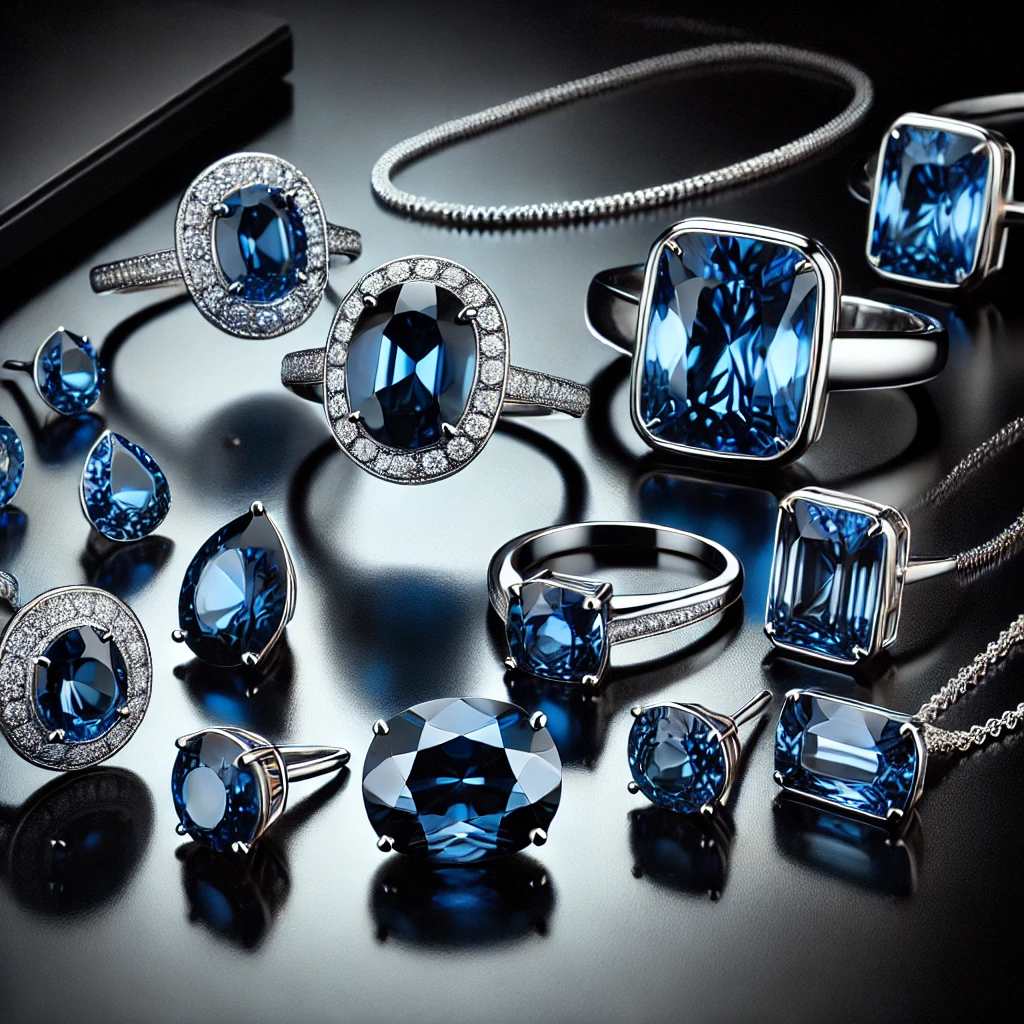Sapphires have captivated human imaginations for millennia with their deep, alluring beauty and rich history. From ancient royalty to modern-day celebrities, these precious gemstones have adorned the most exquisite jewelry pieces, symbolizing wisdom, loyalty, and nobility.
In this article, we’ll explore the multifaceted world of sapphires, delving into their significance in jewelry, metaphysical properties, and cultural importance.
Sapphire in Modern Jewelry
The Role of Sapphire in Engagement Rings
Sapphires have become increasingly popular in engagement rings, offering a unique and colorful alternative to traditional diamond centerpieces. This trend gained significant momentum after Prince Charles presented Lady Diana Spencer with a stunning 12-carat blue sapphire engagement ring in 1981. Today, that same ring adorns the finger of Catherine, Princess of Wales, further cementing the sapphire’s status as a symbol of royal romance.
Modern couples are drawn to sapphires for their:
- Durability (9 on the Mohs scale)
- Variety of colors
- Unique symbolism
- Often more affordable price point compared to diamonds
Iconic Sapphire Jewelry in Pop Culture
Sapphires have left an indelible mark on popular culture, appearing in iconic jewelry pieces worn by celebrities and featured in films. Some notable examples include:
- The Heart of the Ocean necklace from the movie “Titanic”
- Elizabeth Taylor’s sapphire and diamond necklace
- The sapphire and diamond tiara worn by Audrey Hepburn in “Roman Holiday”
These appearances have further elevated the sapphire’s status as a gemstone of glamour and sophistication.

Types of Sapphires
Blue Sapphire: The Most Famous Hue
When most people think of sapphires, they envision the classic deep blue variety. Blue sapphires are prized for their:
- Rich, velvety color
- Association with loyalty and trust
- Timeless elegance in jewelry designs
The most valuable blue sapphires typically come from Kashmir, Burma (Myanmar), and Sri Lanka, known for their intense, pure blue hues with a slight violet undertone.
Other Colors: Pink, Yellow, Green, and More
While blue sapphires are the most well-known, these gemstones actually come in a rainbow of colors, each with its own unique appeal:
- Pink Sapphires: Symbolize love, compassion, and femininity
- Yellow Sapphires: Associated with wisdom, prosperity, and the sun
- Green Sapphires: Represent nature, growth, and tranquility
- White Sapphires: Often used as diamond alternatives, symbolizing purity
- Padparadscha Sapphires: Rare orange-pink variety, highly prized by collectors
Each color variation offers a different energy and symbolism, allowing wearers to choose a sapphire that resonates with their personal style and intentions.
Healing and Metaphysical Properties
Emotional Healing: Calming the Mind and Spirit
Sapphires are believed to have powerful emotional healing properties, including:
- Reducing anxiety and stress
- Promoting mental clarity and focus
- Enhancing intuition and inner wisdom
- Encouraging self-expression and communication
Many people wear sapphires or keep them nearby during meditation or stressful times to harness these calming energies.
Spiritual Connections: Third Eye and Throat Chakras
In spiritual practices, sapphires are closely associated with the Third Eye (Ajna) and Throat (Vishuddha) chakras. They are thought to:
- Open and balance these energy centers
- Enhance psychic abilities and intuition
- Facilitate clear communication of thoughts and feelings
- Promote spiritual enlightenment and higher consciousness
Physical Healing: Benefits for Eyes and Throat
While not a substitute for medical treatment, some believe sapphires can offer physical healing benefits, particularly for:
- Eye health and vision improvement
- Throat and thyroid issues
- Headaches and migraines
- Overall bodily balance and well-being
Astrological and Spiritual Significance
Association with Saturn and Protection in Vedic Astrology
In Vedic astrology, blue sapphires are strongly associated with the planet Saturn (Shani). Wearing a blue sapphire is believed to:
- Provide protection against negative influences
- Enhance discipline and structure in one’s life
- Improve career prospects and financial stability
- Strengthen one’s sense of responsibility and duty
However, it’s important to note that in Vedic astrology, wearing a sapphire is only recommended after careful analysis of one’s birth chart by a knowledgeable astrologer.
Sapphire’s Role in Aligning Chakras
Beyond its association with specific chakras, sapphires are believed to help align and balance the entire chakra system. This alignment can lead to:
- Improved overall energy flow
- Greater sense of physical and emotional balance
- Enhanced spiritual awareness and growth
- Stronger connection between the physical and spiritual realms
Caring for Sapphire Jewelry
To maintain the beauty and integrity of your sapphire jewelry, follow these care guidelines:
- Clean regularly: Use warm water and mild soap with a soft brush to clean your sapphire jewelry.
- Avoid harsh chemicals: Remove sapphire jewelry when using household cleaners or beauty products.
- Store properly: Keep sapphire pieces separate from other jewelry to prevent scratching.
- Professional cleaning: Have your sapphire jewelry professionally cleaned and inspected annually.
- Ultrasonic cleaners: While generally safe for sapphires, avoid if your stone has been treated or has inclusions.
Synthetic vs. Natural Sapphires
Differences and Ethical Considerations
The sapphire market includes both natural and lab-grown (synthetic) options, each with pros and cons:
Natural Sapphires:
- Formed over millions of years in the earth
- Each stone is unique
- Generally more valuable
- May have inclusions or imperfections
- Mining can have environmental and ethical concerns
Synthetic Sapphires:
- Created in laboratories
- Chemically identical to natural sapphires
- Often more affordable
- Can be produced in consistent quality and color
- Environmentally friendly and conflict-free
When choosing between natural and synthetic sapphires, consider factors such as budget, environmental concerns, and personal preferences.
Sapphire Symbolism Across Cultures
Wisdom, Truth, and Loyalty
Across many cultures, sapphires have been associated with:
- Wisdom and knowledge
- Truth and sincerity
- Loyalty and faithfulness
- Royal power and divine favor
These associations have made sapphires popular in everything from royal regalia to engagement rings.
Cultural Variations in Symbolism
While some symbolism is consistent across cultures, there are also interesting variations:
- In ancient Persia, sapphires were believed to color the sky blue
- Hindu traditions associate sapphires with Saturn and karma
- In some European folklore, sapphires were thought to protect against envy and harm
- Ancient Greeks associated sapphires with Apollo and used them for wisdom in interpreting oracles
Investment Value of Sapphires
Factors that Influence Sapphire Value
When considering sapphires as an investment, key factors include:
- Color: Deep, vivid blue is typically most valuable
- Clarity: Fewer inclusions generally mean higher value
- Cut: A well-cut sapphire maximizes color and brilliance
- Carat weight: Larger stones are rarer and more valuable
- Origin: Sapphires from certain locations (e.g., Kashmir) command premium prices
- Treatment: Untreated sapphires are more valuable than heat-treated ones
Always purchase investment-grade sapphires from reputable dealers and consider getting a professional appraisal.
Ethical Considerations in Sapphire Mining
The Growing Demand for Sustainable Sourcing
As consumers become more conscious of the environmental and social impacts of gemstone mining, there’s an increasing focus on ethical sourcing in the sapphire industry. Key considerations include:
- Environmental impact: Ensuring mining practices don’t harm local ecosystems
- Labor conditions: Supporting fair wages and safe working conditions for miners
- Community benefits: Ensuring local communities benefit from sapphire mining
- Traceability: Being able to trace a sapphire’s journey from mine to market
Many jewelers now offer ethically sourced sapphires, and certifications like Fairmined are becoming more common in the industry.
Conclusion
Sapphires stand as a testament to nature’s ability to create objects of extraordinary beauty and significance. From their stunning range of colors to their rich symbolic meanings, these gemstones continue to captivate and inspire. Whether worn for their aesthetic appeal, metaphysical properties, or as investments, sapphires offer a unique combination of beauty, durability, and meaning.
As we appreciate the allure of sapphires, it’s crucial to consider the ethical implications of our choices. By supporting sustainable and responsible sourcing practices, we can ensure that the beauty of sapphires doesn’t come at the cost of environmental degradation or human exploitation.
Whether you’re drawn to the classic blue sapphire or one of its colorful variations, these gems offer a timeless elegance that transcends trends. With proper care, a sapphire can be a cherished possession for generations, carrying with it stories, memories, and perhaps even a touch of magic.
FAQ
Are sapphires more durable than diamonds?
While sapphires are very durable (9 on the Mohs scale), diamonds are still harder (10 on the Mohs scale). However, sapphires are more than suitable for everyday wear in jewelry.
Can sapphires change color?
Some sapphires, known as color-change sapphires, can appear to change color under different lighting conditions. This is a rare and valuable phenomenon.
Are all red corundum stones rubies?
Technically, red corundum is classified as ruby, while all other colors are sapphires. However, the distinction between deep pink sapphires and light red rubies can be subjective.
How can I tell if a sapphire is real?
While professional gemological testing is the most reliable method, some at-home indicators include checking for bubbles (which suggest glass), observing how the stone handles fog from your breath (real sapphires dispel it quickly), and looking for signs of wear (real sapphires are very hard and resist scratching).
Are heat-treated sapphires less valuable?
Heat treatment is a common and accepted practice in the sapphire industry. While untreated sapphires are rarer and more valuable, heat-treated sapphires are still precious gemstones. The treatment should always be disclosed at the time of sale.




One thought on “The Alluring Beauty and Benefits of Sapphire: A Gem of Timeless Elegance”